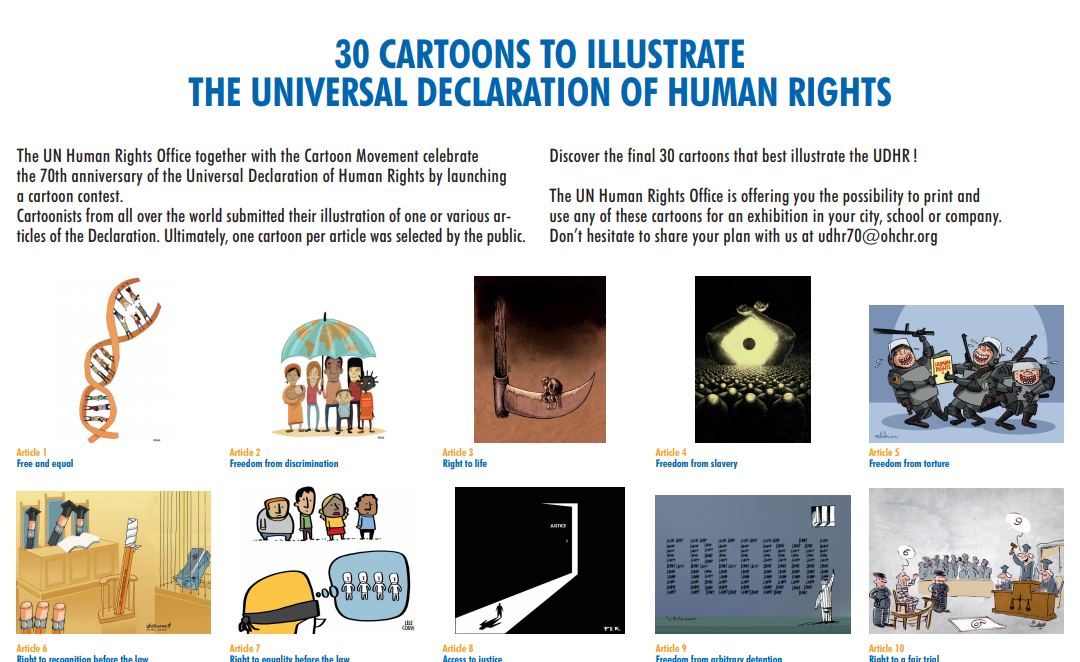By Camilla Carlesi
On the 70th anniversary of the Declaration of Human Rights, adopted on 10 December 1948, the UN Human Rights Office, together with the Cartoon Movement, opened a cartoon contest which selected 30 images out of the more than 500 submissions which best portrayed each of the 30 articles written in the declaration.
Illustrated below are some of this year’s winners of the contest who were published on the Cartoon Movement website:
 Art 1. All human beings are born free and equal in dignity and rights. They are endowed with reason and conscience and should act towards one another in a spirit of brotherhood.
Art 1. All human beings are born free and equal in dignity and rights. They are endowed with reason and conscience and should act towards one another in a spirit of brotherhood.
Art 7. All are equal before the law and are entitled without any discrimination to equal protection of the law. All are entitled to equal protection against any discrimination in violation of this Declaration and against any incitement to such discrimination.
Art. 9. No one shall be subjected to arbitrary arrest, detention or exile.
 Art. 18. Everyone has the right to freedom of thought, conscience and religion; this right includes freedom to change his religion or belief, and freedom, either alone or in community with others and in public or private, to manifest his religion or belief in teaching, practice, worship and observance.
Art. 18. Everyone has the right to freedom of thought, conscience and religion; this right includes freedom to change his religion or belief, and freedom, either alone or in community with others and in public or private, to manifest his religion or belief in teaching, practice, worship and observance.
 Art. 30. Nothing in this Declaration may be interpreted as implying for any State, group or person any right to engage in any activity or to perform any act aimed at the destruction of any of the rights and freedoms set forth herein.
Art. 30. Nothing in this Declaration may be interpreted as implying for any State, group or person any right to engage in any activity or to perform any act aimed at the destruction of any of the rights and freedoms set forth herein.
(go to: https://www.standup4humanrights.org/layout/files/Posters/30_cartoons_UDHR.pdf to see the full album)
These pictures convey a message in a much more effective way than words. Through art, human rights are rediscovered in an understandable format. These cartoons in particular work to motivate its viewers to reflect on their attitude towards the Universal Declaration of Human Rights, and on their general condition. Art has the power to provoke in them the need to change their ethical values. The UNESCO Chair of Bioethics and Human Rights fosters the use of art as a vehicle to promote human dignity and human rights. Moreover, it encourages the use of all arts such as music, architecture, literature, performing arts and dramas in addition to visual art and cartoons to advocate for these moral beliefs.
The 30 pictures created to give life to the articles of the Declaration of Human Rights demonstrate how the Document was just as important 70 years ago as it is today. However, as the Cartoon Movement states, “around the world, we see that human rights are increasingly under pressures and space for civil society, journalists and cartoonists is shrinking.” Therefore, it is our duty to support the spread of these cartoons as a vehicle of sensitization to keep Human Rights alive in order to achieve equality, freedom and peace.
Sources:
https://www.standup4humanrights.org/layout/files/Posters/30_cartoons_UDHR.pdf
https://www.cartoonmovement.com/collection/167
https://www.cartoonmovement.com/project/66
https://www.a-lab.nl/events/human-rights-exposition
https://www.humanrights70.org/#07



